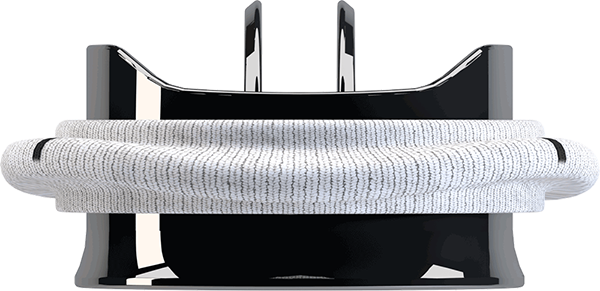
Why ON-X
On-X Heart Valves represent the pinnacle of mechanical heart valve technology resulting in a unique heart valve with exceptional design and material features that are changing the way patients view heart valve replacement options.
Why Use Any Other Mechanical Valve When…
No Other Mechanical Valve Has 90° Leaflets1
No Other Mechanical Valve Has 90° Leaflets

No Other Mechanical Valve Has Flared Inlets1,2
No Other Mechanical Valve Has Flared Inlets
No Other Mechanical Valve Has On-X Carbon3,4
No Other Mechanical Valve Has On-X Carbon
A Valve For Life
Patients younger than 70 years of age undergoing heart surgery with a mechanical heart valve live longer as compared to a tissue valve.5-7 Living longer is known as a “survival benefit” and this can be achieved with the On-X Aortic and Mitral Heart Valves made of pure pyrolytic carbon designed TO LAST A LIFETIME.5-9
On-X Aortic Valve

Clinically Proven To Be Safer
The On-X Aortic Heart Valve is the only mechanical heart valve FDA approved and clinically proven to be safer10 with less anticoagulation and INR level of 1.5 – 2.0.1,11*
87% Lower Bleeding Risk
With 87% reduced bleeding risk10, the On-X Aortic Valve is clinically proven to be safe at lower warfarin dosing and is the only aortic valve supported by the AHA/ACC guidelines11 to be safely managed 50% closer to a normal INR level of 1.5 – 2.0 (vs. 2.0 – 3.0 for other mechanical valves)12
On-X Mitral Valve

The Most Studied Mechanical Mitral Valve
The Prospective Randomized On-X Anticoagulation Clinical Trial (PROACT) Mitral Trial1 is one of the largest studies ever conducted with mechanical mitral valves. PROACT Mitral represents the most contemporary clinical data for any mechanical mitral valve; due to its size and scope, a similar study is likely to never be repeated.16
On-X Aortic Valve

Clinically Proven To Be Safer
The On-X Aortic Heart Valve is the only mechanical heart valve FDA approved and clinically proven to be safer10 with less anticoagulation and INR level of 1.5 – 2.0.1,11*
60% Less Reported Bleeding
With >60% less reported bleeding,10 On-X Aortic Heart Valve is clinically proven, and the only aortic valve supported by the AHA/ACC guidelines11 to be safely managed 50% closer to a normal INR level of 1.5 – 2.0 (vs. 2.0 – 3.0 for other mechanical valves)12
The Only Mechanical Aortic Heart Valve Currently Enrolling PROACT Xa
Hear from An On-X Aortic Heart Valve Patient
On-X Mitral Valve

The On-X Mitral Heart Valve is The Only Mitral Mechanical Valve Participating in An Ongoing Clinical Study
The PROACT Mitral Clinical Study
Hear From An On-X Mitral Heart Valve Patient
Hear from An
On-X Aortic Heart Valve Patient
Hear From An
On-X Mitral Heart Valve Patient
Why On-X References
- On-X Heart Valve Instructions for Use. https://www.onxlti.com/ifu/.
- Gao B. Z., et al. ASAIO Journal 1997;43;5: 396-401.
- Rodriguez-Gabella T, et al. J Am Coll Cardiol 2017;70(8):1013-28.
- Ely J, et al. J Heart Valve Dis 1998;7(6): 626-632.
- Glaser N, et al. Euro Heart J. 2016;37:2658-67.
- Kytö V, et al. The Annals of Thoracic Surgery 2019. https://doi.org/10.1016/j.athoracsur.2019.10.027.
- Diaz R, et al. J Thorac Cardiovasc Surg 2019;158(3):706-14.
- Goldstone AB et al; New Engl J. Med;2017:377:1847-57.
- Data on file: Lifetime of On-X Valve Study.
- Gerdisch MW, et al. J Thorac Cardiovasc Surg (2024), doi: https://doi.org/10.1016/j.jtcvs.2024.04.017.
- Otto CM, et al. Circulation. 2021;143: doi: 10.1161/CIR.0000000000000923.
- MedlinePlus. Normal INR Levels. https://medlineplus.gov/ency/article/003652.htm.
- ClinicalTrials.gov PROACT Xa Study. https://www.clinicaltrials.gov/ct2/show/NCT04142658?term=PROACT+Xa&draw=2&rank=1
- Granger C, et al. N Engl J Med 2011; 365:981-992 DOI: 10.1056/NEJMoa1107039.
- ClinicalTrials.gov PROACT MITRAL. https://clinicaltrials.gov/ct2/show/NCT00291525?term=proact&spons=on-x&draw=2&rank=1.
- Chu M.W.A., et al. (2023). Low-Dose Vs Standard Warfarin After Mechanical Mitral Valve Replacement: A Randomized Trial. Ann Thorac Surg., S0003-4975 (23)00005-X.
Important Safety Information
Know the Facts
Your choice of aortic or mitral heart valve can affect how long and how well you live.
Patient Videos
See what other heart valve patients have to say. Click below to watch videos.
Find a Surgeon
Find an experienced valve replacement surgeon in your area.
